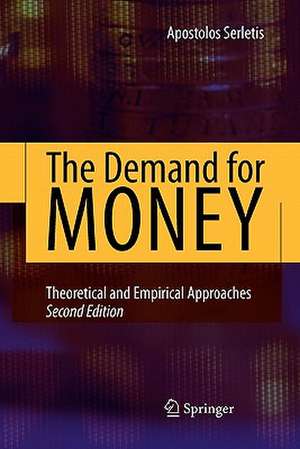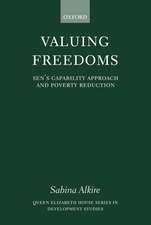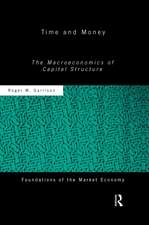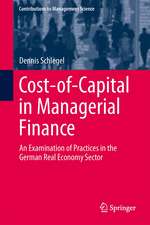The Demand for Money: Theoretical and Empirical Approaches
Autor Apostolos Serletisen Limba Engleză Paperback – 4 noi 2010
| Toate formatele și edițiile | Preț | Express |
|---|---|---|
| Paperback (1) | 949.73 lei 6-8 săpt. | |
| Springer Us – 4 noi 2010 | 949.73 lei 6-8 săpt. | |
| Hardback (1) | 955.88 lei 6-8 săpt. | |
| Springer Us – 27 iun 2007 | 955.88 lei 6-8 săpt. |
Preț: 949.73 lei
Preț vechi: 1158.20 lei
-18% Nou
Puncte Express: 1425
Preț estimativ în valută:
181.73€ • 189.74$ • 150.40£
181.73€ • 189.74$ • 150.40£
Carte tipărită la comandă
Livrare economică 04-18 aprilie
Preluare comenzi: 021 569.72.76
Specificații
ISBN-13: 9781441944061
ISBN-10: 1441944060
Pagini: 408
Ilustrații: XXIV, 382 p.
Dimensiuni: 155 x 235 x 21 mm
Greutate: 0.57 kg
Ediția:Softcover reprint of hardcover 2nd ed. 2007
Editura: Springer Us
Colecția Springer
Locul publicării:New York, NY, United States
ISBN-10: 1441944060
Pagini: 408
Ilustrații: XXIV, 382 p.
Dimensiuni: 155 x 235 x 21 mm
Greutate: 0.57 kg
Ediția:Softcover reprint of hardcover 2nd ed. 2007
Editura: Springer Us
Colecția Springer
Locul publicării:New York, NY, United States
Public țintă
ResearchCuprins
Static Monetary Macroeconomics.- Classical Macroeconomic Theory.- Keynesian Macroeconomic Theory.- Dynamic Monetary Macroeconomics.- Models with Rational Expectations.- Neoclassical Growth Theory.- Monetary Growth Theory.- The Welfare Cost of Inflation.- Theoretical Approaches to the Demand for Money.- The Classics, Keynes, and Friedman.- Transactions Theories of Money Demand.- Portfolio Theories of Money Demand.- Empirical Approaches to the Demand for Money.- Conventional Demand for Money Functions.- Modeling Trends in the Variables of the Money Demand Function.- Cointegration and the Aggregate Demand for Money Function.- Balanced Growth, the Demand for Money, and Monetary Aggregation.- Cross-Country Evidence on the Demand for Money.- Microfoundations and Monetary Aggregation.- The Microeconomic Foundations of the Definition of Money.- The New Monetary Aggregates.- Nominal Stylized Facts.- Microfoundations and the Demand for Money.- The Nonparametric Approach to Demand Analysis.- The Parametric Approach to the Demand for Monetary Assets.- Locally Flexible Functional Forms and Demand Systems.- Globally Flexible Functional Forms and Demand Systems.- Microeconometrics and the Demand for Money.- The Econometrics of Demand Systems.- Applied Monetary Demand Analysis.- Future Research Agenda.
Notă biografică
Apostolos Serletis is University Professor and Professor of Economics and Finance at the University of Calgary. Since receiving his Ph.D. from McMaster University in 1984, he has held visiting appointments at the University of Texas at Austin, the Athens University of Economics and Business, and the Research Department of the Federal Reserve Bank of St. Louis.
Professor Serletis’ teaching and research focus on monetary and financial economics, macroeconometrics, and nonlinear and complex dynamics. He is the author of eight books, including The Theory of Monetary Aggregation, co-edited with William A. Barnett (Elsevier 2000), Financial Markets and Institutions: First Canadian Edition, with Frederic S. Mishkin and Stanley G. Eakins (Addison Wesley 2004), Money and the Economy (World Scientific 2006), The Economics of Money, Banking, and Financial Markets: Third Canadian Edition, with Frederic S. Mishkin (Addison Wesley 2007), Functional Structure Inference, co-edited with William A. Barnett (Elsevier 2007), and Quantitative and Empirical Analysis of Energy Markets (World Scientific 2007).
In addition, he has published close to 150 articles in such journals as the Journal of Economic Literature, the Journal of Monetary Economics, the Journal of Money, Credit and Banking, the Journal of Econometrics, the Canadian Journal of Economics, the Journal of Economic Dynamics and Control, the Journal of Business and Economic Statistics, the Journal of Banking and Finance, the Journal of Applied Econometrics, and Macroeconomic Dynamics.
Professor Serletis is an Associate Editor of Macroeconomic Dynamics and a member of the editorial board at two academic journals, the Journal of Economic Asymmetries and the Journal of Economic Studies. He lives in Calgary, with his wife Aglaia.
Professor Serletis’ teaching and research focus on monetary and financial economics, macroeconometrics, and nonlinear and complex dynamics. He is the author of eight books, including The Theory of Monetary Aggregation, co-edited with William A. Barnett (Elsevier 2000), Financial Markets and Institutions: First Canadian Edition, with Frederic S. Mishkin and Stanley G. Eakins (Addison Wesley 2004), Money and the Economy (World Scientific 2006), The Economics of Money, Banking, and Financial Markets: Third Canadian Edition, with Frederic S. Mishkin (Addison Wesley 2007), Functional Structure Inference, co-edited with William A. Barnett (Elsevier 2007), and Quantitative and Empirical Analysis of Energy Markets (World Scientific 2007).
In addition, he has published close to 150 articles in such journals as the Journal of Economic Literature, the Journal of Monetary Economics, the Journal of Money, Credit and Banking, the Journal of Econometrics, the Canadian Journal of Economics, the Journal of Economic Dynamics and Control, the Journal of Business and Economic Statistics, the Journal of Banking and Finance, the Journal of Applied Econometrics, and Macroeconomic Dynamics.
Professor Serletis is an Associate Editor of Macroeconomic Dynamics and a member of the editorial board at two academic journals, the Journal of Economic Asymmetries and the Journal of Economic Studies. He lives in Calgary, with his wife Aglaia.
Textul de pe ultima copertă
The Demand for Money:
Theoretical and Empirical Approaches
2nd Edition
by Apostolos Serletis
This book provides an account of the existing literature on the demand for money. It shows how the money demand function fits into static and dynamic macroeconomic analyses and discusses the problem of the definition (aggregation) of money. Professor Serletis takes a microeconomic- and aggregation-theoretic approach to the demand for money, presents empirical evidence using recent state-of-the-art econometric methodology, and recognizes the existence of unsolved problems and the need for further developments.
New to this Edition
-William A. Barnett, Oswald Distinguished Professor of Macroeconomics, University of Kansas, and Editor of the journal, Macroeconomic Dynamics
"The second edition contains new theoretical and empirical results on the theory of the demand for money. Serletis expands on the base that he created in his first edition. New results on the estimation of flexible monetary asset demand systems are included in this edition as well as new time series econometric techniques. This book is a significant contribution to macroeconomics, and provides a basis for graduate students from which they can start their own research."
-Melvin J. Hinich, Department of Government & Department of Economics, The University of Texas at Austin
Theoretical and Empirical Approaches
2nd Edition
by Apostolos Serletis
This book provides an account of the existing literature on the demand for money. It shows how the money demand function fits into static and dynamic macroeconomic analyses and discusses the problem of the definition (aggregation) of money. Professor Serletis takes a microeconomic- and aggregation-theoretic approach to the demand for money, presents empirical evidence using recent state-of-the-art econometric methodology, and recognizes the existence of unsolved problems and the need for further developments.
New to this Edition
- increased coverage of theoretical and empirical approaches to the demand for money, including a new chapter on cross-country evidence
- a new chapter on money demand issues and estimation of the welfare cost of inflation using tools from public finance and applied microeconomics
- a new chapter on rational expectations macroeconomics and issues such as the Lucas critique, rules versus discretion, and time inconsistency
- increased coverage of the univariate and multivariate properties of the money demand variables, nonlinear chaotic dynamics, and self-organized criticality
- revised coverage of monetary asset demand systems based on locally and globally flexible functional forms
- increased coverage of the econometrics of demand systems highlighting the challenge inherent with achieving both economic and econometric regularity
-William A. Barnett, Oswald Distinguished Professor of Macroeconomics, University of Kansas, and Editor of the journal, Macroeconomic Dynamics
"The second edition contains new theoretical and empirical results on the theory of the demand for money. Serletis expands on the base that he created in his first edition. New results on the estimation of flexible monetary asset demand systems are included in this edition as well as new time series econometric techniques. This book is a significant contribution to macroeconomics, and provides a basis for graduate students from which they can start their own research."
-Melvin J. Hinich, Department of Government & Department of Economics, The University of Texas at Austin
Caracteristici
Increased coverage of theoretical and empirical approaches to the demand for money, including a new chapter on cross-country evidence A new chapter on money demand issues and estimation of the welfare cost of inflation using tools from public finance and applied microeconomics A new chapter on rational expectations macroeconomics and issues such as the Lucas critique, rules versus discretion in monetary policymaking, and time inconsistency Increased coverage of the univariate and multivariate properties of the money demand variables, nonlinear chaotic dynamics, and self-organized criticality Revised coverage of monetary asset demand systems based on locally flexible functional forms such as the translog, generalized Leontief, almost ideal demand system, Minflex Laurent, and the Normalized Quadratic reciprocal indirect utility function Revised coverage of monetary asset demand systems based on globally flexible functional forms such as the Fourier and the Asymptotically Ideal Model Increased coverage of the econometrics of demand systems highlighting the challenge inherent with achieving both economic and econometric regularity A chapter with suggestions for potentially productive future research Includes supplementary material: sn.pub/extras
















